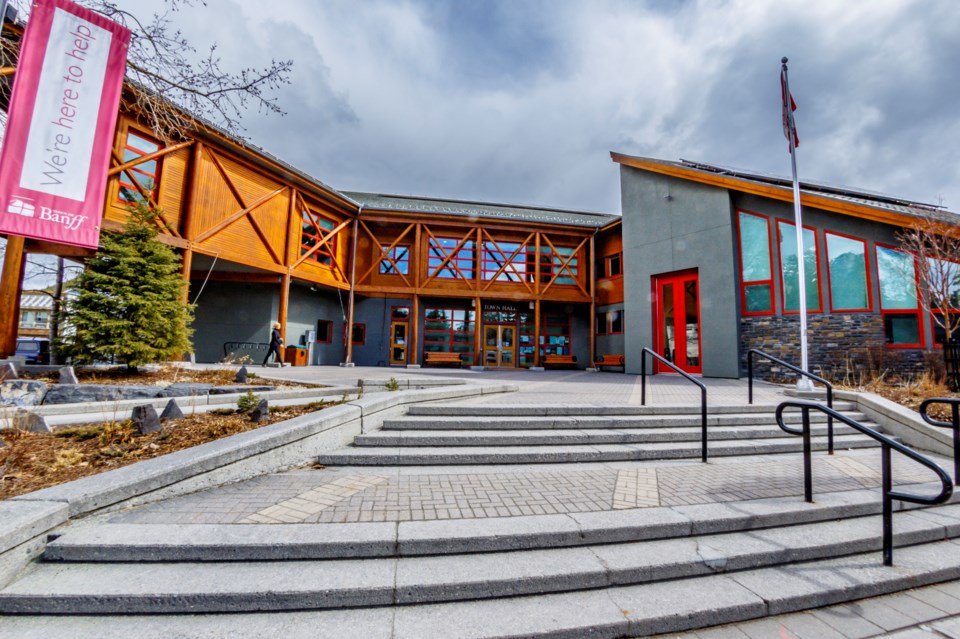BANFF – The Town of Banff’s residential parking permit system is driving tourists wanting to avoid paying for parking out of residential neighbourhoods as intended.
Town of Banff officials say the residential parking permit (RPP) system has created parking capacity, noting there is about 50 per cent occupancy during peak periods and Banff residents account for approximately 72 per cent of the parked cars.
“The RPP program is working well,” said Avery Vanwynsberghe, GIS asset management technician for the Town of Banff, during a council meeting Monday (April 8), noting the vacant stall count increased from 60 in 2019 to 304 in 2023.
“There’s a lot of spaces available for residents and it’s freed up 244 stalls. It is effective at relocating visitors to other parking spaces and leaving spaces open for residents.”
Banff’s RPP system for neighbourhoods immediately surrounding the downtown visitor paid parking zone was implemented in July 2021 as part of a comprehensive parking management plan to deal with parking and traffic troubles.
The primary intent of the RPP program was to prevent the spillover of vehicles into residential neighbourhoods from visitors seeking to avoid paying for downtown parking.
To determine how full on-street parking stalls are and to investigate where cars were from, four audits were conducted in the peak summer times in August and the days leading up to Christmas in December.
Licence plate recognition technology was used to scan plates in residential areas near the downtown, with Vanwynsberghe noting that parking spaces in residential areas beyond the RPP zone were “still pretty empty.”
“We drove around targeted streets to scan plates and this gave us a list of 1,000 plates and from there we were able to determine the occupancy and composition,” said Vanwynsberghe.
“We were able to use the list of plates and list of parking permit holders and we were able to determine if they had a permit or not.”
Based on the results of the surveys, resident parking permit holders made up the majority of parked cars; however, in December there was a large increase in the number of vehicles parked without valid permits.
After getting information from the province on where the vehicles were registered, the results showed most vehicles were from outside Alberta (33 per cent); Calgary (22 per cent), Edmonton (11 per cent), Canmore (five per cent) and other municipalities. (four per cent).
However, 27 per cent of vehicles without a permit to park in the residential areas were from Banff.
“This could mean they are residents but don’t drive downtown and live outside the RPP and feel they don’t need a permit, or they’re temporary residents who are unaware of the permits available for temporary residents,” said Vanwynsberghe.
Mayor Corrie DiManno said learning that 72 per cent of registered residents are parked in the RPP zone as well as having 50 per cent occupancy during peak times “really shows me that this program is working and that is really phenomenal to see.”
She said she believes there are systems in place to help address that lagging 28 per cent.
“I am really heartened to hear about the education and awareness we try to do, whether it’s through municipal enforcement or education,” she said.
“That’s really helpful, especially as we know that the last five years 30 per cent of our population is new to Banff.”
The mayor said moving from 205 vacant stalls in 2022 to 304 in 2023 is “super encouraging.”
She said this is crucial information as council navigates housing policy changes to increase housing supply, including a proposed bylaw to eliminate minimum parking requirements for new residential housing development.
“I am really glad we have this data in front of us,” she said.
Darren Enns, director of planning and environment for the Town of Banff, cautioned this was a limited data set and spoke to the benefits of long-range data.
“If council is looking at data for policy decisions, I suggest service review would be a good time for discussion to collect ongoing data,” he said.




